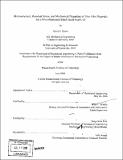| dc.contributor.advisor | Brian L. Wardle. | en_US |
| dc.contributor.author | Quinn, David John, Sc. D. Massachusetts Institute of Technology | en_US |
| dc.contributor.other | Massachusetts Institute of Technology. Dept. of Mechanical Engineering. | en_US |
| dc.date.accessioned | 2007-02-21T13:13:46Z | |
| dc.date.available | 2007-02-21T13:13:46Z | |
| dc.date.copyright | 2006 | en_US |
| dc.date.issued | 2006 | en_US |
| dc.identifier.uri | http://hdl.handle.net/1721.1/36244 | |
| dc.description | Thesis (S.M.)--Massachusetts Institute of Technology, Dept. of Mechanical Engineering, 2006. | en_US |
| dc.description | Includes bibliographical references (p. 173-184). | en_US |
| dc.description.abstract | The microstructure and residual stress of sputter-deposited films for use in microfabricated solid oxide fuel cells are presented. Much of the work focuses on the characterization of a candidate solid electrolyte: Yttria Stabilized Zirconia (YSZ). Stress and structure of reactive RF sputtered YSZ films are explored as a function of thickness (5nm - 1000nm), deposition pressure (5mtorr - 1OOmtorr), and substrate temperature (room temperature, 3000C and 6000C). Microstructure is characterized by x-ray diffraction (XRD), transmission electron microscopy (TEM), and scanning electron microscopy (SEM). Film composition, specifically impurity content, is investigated with secondary ion mass spectroscopy (SIMS). Results indicate that YSZ films likely have a columnar structure with fully cubic crystalline phases of (100) texture with mixed amorphous/crystalline phases. Residual stress is measured via substrate curvature techniques. Results indicate that the as-deposited residual stress of YSZ ranges from -1.4 GPa to 400MPa with variations in sputtering conditions. Transitions from compressive to tensile stress are identified with variations in working pressure and film thickness. | en_US |
| dc.description.abstract | (cont.) The origins and variations in as-deposited stress are determined to be from two primary mechanisms: tensile stress due to grain coalescence/growth and compressive stresses due to forward sputtering of target atoms (also known as "atomic peening" stresses). Due to the expected high-temperature operation (-1 0000C) of microfabricated solid oxide fuel cells, the evolution of residual stress with post deposition thermal cycles is also explored. Results indicate significant stress hysteresis (nearly 1GPa tensile) for films deposited at room temperature and low working pressures with a transition from compressive to tensile stress beginning at approximately 150°C. This hysteresis is believed to be due to the diffusive relief of compressive stresses generated by "atomic peening" during deposition. In addition to stress and structure characterization, preliminary mechanical property characterization was completed through inferences made from stress-temperature cycles of films deposited under various conditions, and a series of nanoindentation tests on room-temperature YSZ films. | en_US |
| dc.description.abstract | (cont.) Results indicate a low in-plane stiffness, believed to be the result of a mixed amorphous-crystalline structure, and an out of plane stiffness comparable to or higher than bulk properties, believed to be due to the texture of crystalline phases. Preliminary residual stress characterization of co-sputtered Pt-YSZ anode and cathode materials and fuel cell trilayers of Pt-YSZ/YSZ/Pt-YSZ is also presented. The implications of this work on the design and fabrication of structurally viable microfabricated solid oxide fuel cell devices are discussed. | en_US |
| dc.description.statementofresponsibility | by David J. Quinn. | en_US |
| dc.format.extent | 184 p. | en_US |
| dc.language.iso | eng | en_US |
| dc.publisher | Massachusetts Institute of Technology | en_US |
| dc.rights | M.I.T. theses are protected by copyright. They may be viewed from this source for any purpose, but reproduction or distribution in any format is prohibited without written permission. See provided URL for inquiries about permission. | en_US |
| dc.rights.uri | http://dspace.mit.edu/handle/1721.1/7582 | |
| dc.subject | Mechanical Engineering. | en_US |
| dc.title | Microstructure, residual stress, and mechanical properties of thin film materials for a microfabricated solid oxide fuel cell | en_US |
| dc.type | Thesis | en_US |
| dc.description.degree | S.M. | en_US |
| dc.contributor.department | Massachusetts Institute of Technology. Department of Mechanical Engineering | |
| dc.identifier.oclc | 77274553 | en_US |
